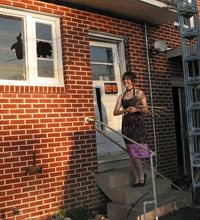
Photo: Jessica Emerson
The Liberal Arts lounge at the University of New Orleans may not have a proper floor—”I don’t know that it ever will,” sighs the English department chair—but that hardly distracted from the ambience provided by a disco ball, multicolored lights, and metallic foil curtains on a balmy Saturday night this spring.
For the third year running, UNO’s Creative Writing Workshop hosted a prom. The CWW’s applications are down more than 25 percent since Katrina, but its budget is, for this institution, surprisingly intact, and the program kicked a couple hundred dollars toward booze and balloons for the event. Besides, the university has designated CWW, some of whose five dozen students plastered posters around campus and sold $5 tickets to help cover costs, a Department of Excellence. “So we’re earmarked for money,” director Joanna Leake says. “If money ever comes.”
In December 2005, Congress ponied up $200 million of the requested $500 million for Gulf Coast higher education relief, and a panicked Louisiana cut its colleges’ budgets an average of 6 percent. UNO’s was slashed by 12. Before Katrina, the school boasted 17,000 students, more than 90 percent of whom were—unlike many students at the city’s other major universities, Tulane and Loyola—locals; after the storm, its website implored students to “Come Home to UNO.” When fewer than 12,000 showed up last fall, the school had to score the budget again, losing a full fifth in just one year.
The campus needed $100-$150 million in repairs: wind and electrical feeder damage led to water and mold damage; a few buildings flooded; the 2,500 starving low-ground evacuees and air- and boat-rescued residents deposited at those that didn’t broke windows and doors to raid faculty offices for potato chips. Administrators are waiting for Congress to waive the state’s responsibility for 10 percent of the bill (as it did for New York in 2001); even if it does, FEMA still hasn’t decided whether fixing the student center, the Alumni and Development Center, the arena, and a student housing complex falls under its purview. To get by, the university cut 85 faculty positions and 5 degrees, and pared down courses and electives and even the school week, which is now only four days long.
You wouldn’t guess its troubles to look at the school’s social calendar. Spring 2006 semester opened late and, in many departments, without various amenities—air conditioning, copiers, internet access, windows, bathroom plumbing—but even while a national debate raged about whether a broke, broken city should throw its annual $5 million Mardi Gras, the UNO Student Activities Council was ordering ten thousand pounds of crawfish for the yearly blowout on the quad. The Department of Earth and Environmental Science, down 35 percent of its students, four faculty, and the use of its entire busted building, dropped $1800—more than four times the usual expense—on seafood and beer for its traditional mineral auction. And CWW students hauled enormous garbage bags full of rotting literature, faculty family pictures, and deserted sweaters out of the Liberal Arts building and went shopping for a new crown; the one the first prom queen wore was destroyed during mold remediation.
This year, two post-Katrina proms later, high-heeled goers didn’t have to keep their shoes on for fear of Electric Sliding through chunks of jagged glass, and the adjacent candlelit courtyard was free of scaffolding. But the mayor’s most recent redevelopment plan didn’t cover the neighborhoods around UNO that took in water to the eaves. The DJ brought his equipment from the only restored house on his gutted, abandoned street, and attendees still dodged holes in the asphalt as they drove past waterlines and mountains of debris in gowns, polyester suits, and pink lace gloves. The school’s chancellor, Tim Ryan, is pushing to get the vicinity included in the next phase of the city’s recovery. “You make do with what you have,” he says. “But it’s hard to come to school when it’s an oasis in the middle of a wasteland.”
Around midnight, the king and queen were crowned. An hour later, when the cookie trays and liquor bottles on the tables were empty, the long, narrow room began to clear out, the revelers stumbling across campus. They carried their shoes through the parking lot, still dancing, singing their way back to their cars as Army Corps machines loomed over the levee a few hundred yards away, quiet in the darkness.














